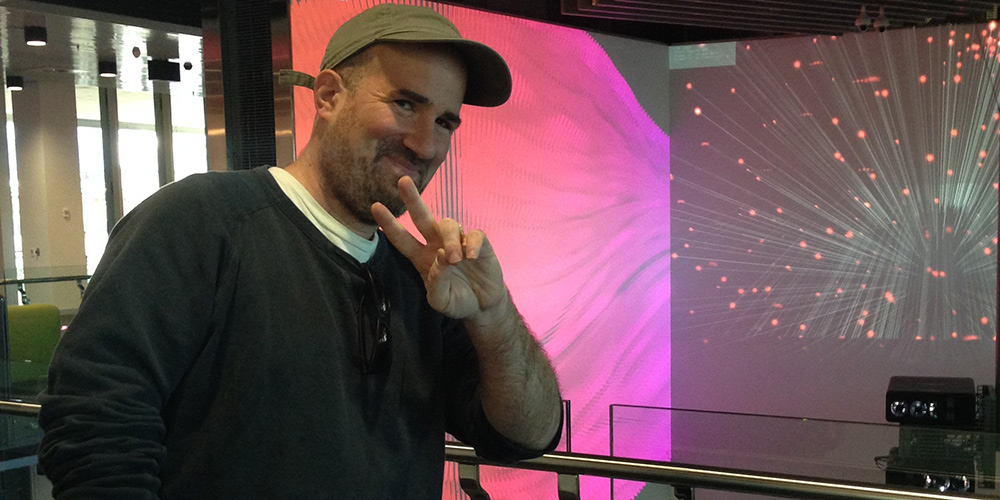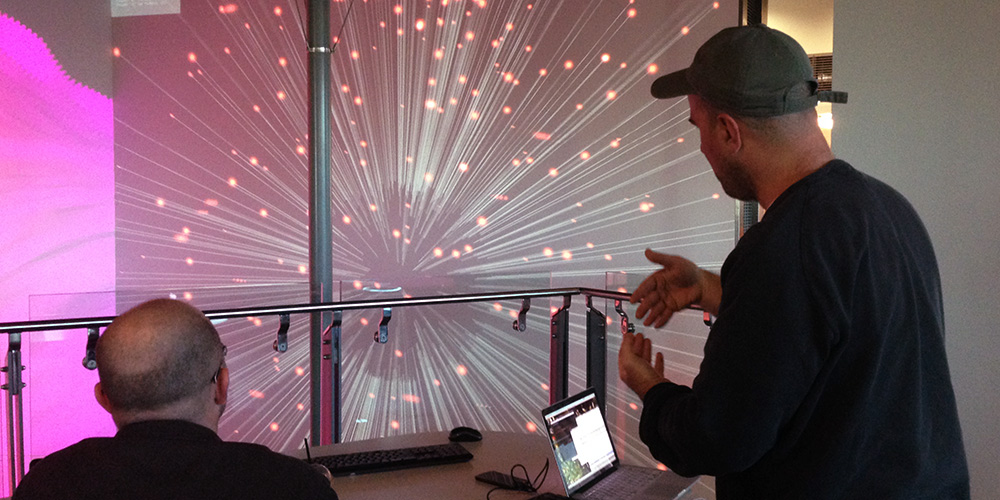
Photo: QUT
Zachary Lieberman started the first part of his TRANSMIT³ residency at The Cube at the QUT in August 2014. During the course of the residency he will create a series of experiments investigating scale as a means of showing the creative power of code. The starting point for this project is the “Powers of Ten” movie by Charles and Ray Eames. During the residency further openFrameworks code artists are commissioned to create responsive animation depicting different scales that are informed by discussions with QUT staff and faculty around their work: How do cells move? How do mountains form? How do solar systems operate? Usually, these questions inform PHD research and scientific investigation, but they can also be interesting starting points for artistic investigation as well. Additionally, they look at simple experiments which scale together.
[youtube=https://www.youtube.com/watch?v=0fKBhvDjuy0&w=610]
Zachary Lieberman is also teaming up with QUT students, via QUT’s Creative Industries Project elective. The participating students come from a combination of undergraduate Creative Industries and Science and Engineering faculty areas.
In the first interview about his residency at The Cube Zachary Lieberman talks with Lubi Thomas, Senior Curator of The Cube at the Queensland University of Technology (QUT), about what inspired him about this project.
Lubi, first I have a question for you. What do you think is special about TRANSMIT³, the joint residency Program of QUT and Ars Electronica? What is your perspective on it?
Lubi Thomas: TRANSMIT³ is a project about possibilities that enables innovation and inspiration in our residents, participant students, research communities and general publics. TRANSMIT³ is about bringing elite practitioners to The Cube and through their projects exploring the capabilities of The Cube as both a hardware/software object and also as a site for public engagement, discovery and inspiration. We hope that The Cube affords our residents an opportunity to extend their knowledge as they tackle the challenges and possibilities that this site offers. The outcomes, of which, help to expand our vision of what is possible with The Cube.
It’s all about discovery, knowledge sharing and creative invention expanding our ideas of success at The Cube.
Why did you decide to participate in the TRANSMIT³ residency?
Zachary Lieberman: First of all I was very interested in the residency because it was with Ars Electronica that I have a long history with and experience with and because QUT is for me a really exciting place to be. It seems like a really interesting University and there is a lot of unique research happening there and interesting people. As soon as I got to know Lubi Thomas who is curating The Cube and the rest of the team there I really felt like it’s going to be a great space to come and visit.

Photo: QUT
What inspired you about this project?
Zachary Lieberman: What inspires me about this project is that it is an opportunity to create an art work but also connect with different scientists and researchers that are working within the university. So the nature of this project is that it’s going to be a kind of mechanism for having conversations with the people on the university beyond the people in this building around The Cube but actually around the campus and other campuses. For me it’s really exciting to connect people.
Lubi Thomas: I like the way that you are utilizing a project for The Cube which is in the Science and Engineering building as a way of actually creating tentacles and some pathways out into what is a massive university, a lot of who never come into this space. So you are giving them connections that start to make The Cube relevant to them. I think that that’s an extremely strong idea. And what is fascinating about scale I guess maybe it’s some scale in terms of The Cube but also the lens through which, you know, you are already thinking about this project as well.

Photo: QUT
Zachary Lieberman: You know The Cube itself is really large; from photographs it seems quite large, but being here it’s impressively large. It’s a two story projection and LCD display. For me it’s an enormous surface. And I have to ask the question what it does mean to have this kind of surface in the environment that you are in. Especially as it is not like in an empty building, but actually there is hundreds and hundreds, thousands of students around it. The building is quite active and you see students studying and talking and working in this space. What does it mean to have this kind of thing that we are basically living around? For me this makes it really exciting to create something because it’s going to be creating an artwork on a single display in a corner in a back room, but that is a kind of a hub or a center for the building. Especially as architecturally the building seems to go around The Cube; it flows around it. The final outcome of my work will be something everybody is confronted with and is living around it.
Lubi Thomas: Also there is a really interesting aspect about it which is rare, I think, for a university: it actually turns into this public space as there are lots of families and kids that come here as a destination. I think that is a nice opportunity to create something where you have got these diverse and unknown audiences. Through the project you intend to communicate something about the university that is often not communicated, even to the undergraduate students. It certainly is a challenge to communicate these topics, questions and research outcomes to the greater general public, stating what we do here at the university. Your project is really tackling that.
Zachary Lieberman: It’s going to attempt to at least try to identify one of the key questions that are being asked here at the university and asks what this research does mean. How do we tell the story of what’s happening here? Universities publish magazines or publish websites and there is ways to tell the story of the work in a very straight forward way, even in a kind of PR or news sense, but this my project at The Cube is a very interesting, unique and pure way to tell the story of what’s happening here, to create responses, and to really say what are the fundamental questions that researchers are asking. It also shows what an artistic response to that looks like.
Maybe the one question we explore is about black holes or mapping the genome or trying to come up with a model of the brain or trying to understand how cells work or understand how atoms work. Those questions are interesting and meaningful and profound.
I think they make great starting points for a conversation, for artistic conversations, and great starting points for people to work visually and to create, through a movement and through interaction, responsive forms that attempt to show these questions, possibly even show answers to these questions.
Lubi Thomas: Above that, describing in another language is really powerful. Therefore the content of the research has to be thought differently and described in a new language – may it be in a non-scientific structure or even visually. Some people can consume ideas easily and make sense of information through reading different kinds of texts but for others it actually is the visual language as well as the visual or an emotive response that gives them the hook into being able to understand what the research is or what the questions is that are driving research projects. The vision of bringing those different spaces and kinds of expression together is something that The Cube is really about. Moreover, The Cube is about bringing individual or independent disciplines together, to create intersections and spaces where things do well that often don’t do well together.

Photo: QUT
So, what do you think is the biggest challenge for this project?
Zachary Lieberman: The biggest challenge with a project like this is that there are a lot of stakeholders and a lot of people involved. Part of the difficulty is that I’m coming from really far away and I’m here for a short period of time. So there’s a lot if alignment that has to happen between different people and different interests. That’s the challenge. I think that also the distance presents some interesting and hard challenges about communication because New York and Brisbane are about 12, 13 to 14 hours away from each other. That distance tends to make communication go a lot slower. For example, you are writing an email and wait a day to get a response and wait a day and so on. But it also, I think, has kind of an interesting quality to slow down communication.
Maybe you take a little more time for responding as your words are more important in this not so fast communication. Somehow it feels like getting reminded of that it used to take weeks to get responses, to write letters and postcards to each other, what made communication more precious and conscious.
So the distance is a big challenge but I think also creates a lot of opportunity. I don’t think it will be difficult to work with the students. I have met with the students and I’m really excited to jam with them. I think that it’s going to be an interesting challenge to have this group of students reaching out to people at the university and navigating and mapping it out. I think that’s going to be an awesome challenge. The actual work, I think, will come easily, if we get good questions and we get good topics I think everything will fall into place. The challenge right is to make sure that we identify this and come up with a good map between now and November and then to March or April.
Lubi Thomas: Yes, absolutely.
How do you interact with students, researchers and other key staff? It’s a combination of ways really, isn’t it?
Zachary Lieberman: The most important thing is developing, having face to face relationships. Then we have email, phone calls and skype and so on, but that face to face relationship in the beginning is really crucial. For me that’s extremely important. I even want to spend some hours with students this week to get to know their names, and their background and what their passion is about. I want to know what they are interested in and I want them to get to know me, so that we can go back. And that when I go back and work in remotely, that we are able to jam and coordinate and collaborate and I don’t think that can happen without face to face.
Lubi Thomas: I couldn’t agree with you more, I think it absolutely is the base established for everything, isn’t it?
Zachary Lieberman: Yeah, it is. So much about our communication is about email and other electronic ways which are really not very personal. It’s hard to understand tone and understand kind of feeling. For me that’s a very important part of this project. I don’t think you can do this work without having an initial trip like this to understand everybody, personalities and get a feeling of who they are and for them to get a feeling for who you are. That’s why I am asking for this when I come here for the first time.
Lubi Thomas: And that has played out crucially this week, we have gone from a lot of apprehension to actually just getting people to hang out with you and they have gone 180.
Zachary Lieberman: Yeah exactly, that is about really meeting and understanding, understanding where people are coming from. It’s kind of abstract if you say that this artist in residence is coming, here’s the URL, here is some Bio, it’s still very abstract.
